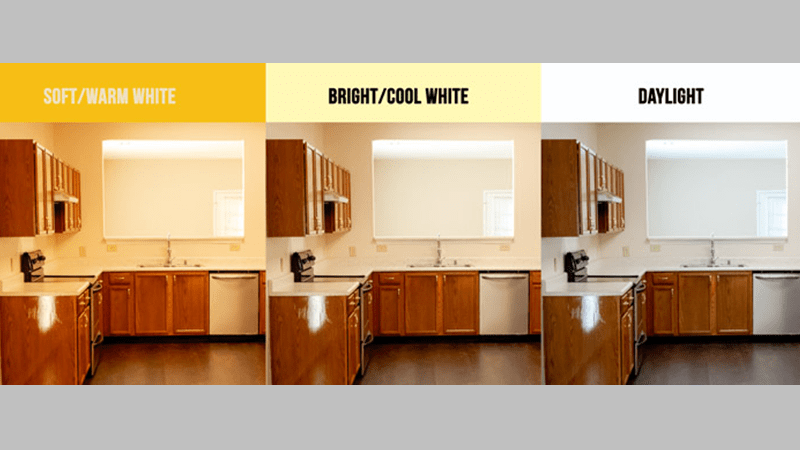
Cool White VS Daylight, Which Is Brighter?
You’re trying to choose one between cool white or daylight and want to know which is brighter. Both provide a clean, white light but have different color temperatures that might affect how brightly they illuminate a space. As an average consumer, brightness plays into your buying decision big-time. Before you head out shopping, let’s explore the difference between these two popular choices of bulbs so you can make a good decision. By the end of this quick guide, you’ll know whether cool white or daylight is the right bulb for you if brightness is your top priority.
What Is Cool White Lighting?
Cool white lighting means using the type of lighting that is extensively used for works and room illumination because it is bright, clean, and notable. As compared to soft bulbs, cool white bulbs simply emit a bluish-white light that closely resembles natural light.
Clean illumination and cool white lighting are alluring in both commercial and living environments. It’s particularly favored in offices, classrooms, workshops, and utility areas where productivity and accuracy are important.
Combining task and accent lighting with softer ambient light can be advisable for total effect for best lighting balance. You could enjoy light brightness when needed while enjoying the cozy warmth of softer, warmer light during relaxation time. Color temperature balanced will create an atmosphere welcoming feeling.
What Is Daylight Lighting?
Daylight lighting tends to mimic sunlight by supplying bright and uniformly distributed illumination. The Daylight bulbs normally have a color temperature between 5,000 to 6,500 Kelvin. This higher Kelvin rating tends to produce bluer light compared to low color temperatures of 3,000K, producing a yellower type of light.
Because of their brightness level, daylight lights are used as task lighting in workstations or places where focused illumination is needed.
White and warm white bulbs do not emit as much light making them equivalent to a 60W emitting 800 – 900 lumens. The brightness of the light helps keep you attentive and eye strain.
Which Light Bulb Type Is Brighter? Cool White vs Daylight
Both Cool White and Daylight bulbs can provide lighting. There are some important differences to consider when choosing a street light between them.
Brightness
Compared to daylight bulbs, generally, they give more vivid light than Cool White. These daylight bulbs imitate lighting and ordinarily have a color temperature between 5500K to 6500K. This provides the light with a bluer tone only. On the other hand, a cool white bulb emits a white light with an approximate 4000K color temperature. Though bright, it still appears yellow in comparison.
If you need brightness for tasks in spaces like workspaces or garages, Daylight bulbs would be your option. They can make fine details and colors appear sharper and more vivid. However, some persons might find the hue of Daylight bulbs harsh for living spaces. Sometimes, Cool White bulbs offer lighting for most general purposes while providing a softer, warmer tone that many people find pleasant and relaxing.
Your choice will depend on how you define brightness and where you intend to place it. These two bulbs’ illumination is the same – Daylight and Cool White. They differ in terms of the color scheme as well as intensity. Daylight bulbs offer task lighting, while Cool White bulbs deliver a brighter, warmer white light that makes it feel cozy.
Recommendations for Your Space
Factors affect the decision when comparing Cool White and Daylight bulbs for your space. That major difference lies in color conversation, which impacts the brightness and the overall atmosphere.
Cool White (2700K to 4100K)
Cool white bulbs emit a glow that works well in living rooms, bedrooms, and dens. The lower color temperature creates a relaxing environment. These bulbs are perfect for lighting or accent lighting in living spaces where you want to create an atmosphere.
Daylight (5000K to 6500K)
The light from daylight bulbs is crisp so that it closely resembles sunlight. The higher color temperature is ideal for workspaces, kitchens, or garages, as well as bathrooms where you need illumination to perform tasks or activities. Daylight bulbs help eliminate disorder by boosting alertness and productivity benefits. They also serve as lighting when paired with natural light on windows.
Conclusion
Concerning brightness, both cool white and daylight bulbs have their features and drawbacks. It’s all about what you need and prefers for your space. Want a bright glow that keeps you alert? Try daylight. Prefer a softer, more relaxing ambiance? Cool white probably fits the bill best of all. Most importantly, you wind up with lighting that feels good on your feelers and enhances how you use your home. Now that you know the difference, you can confidently shop for bulbs and choose just the right brightness for your purposes.







